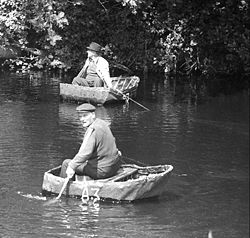River Teifi



The River Teifi or Tivy for most of its 75-mile length forms the boundary between the counties of Cardigan and Carmarthen and then that of Cardiganshire with Pembrokeshire to the sea (making it the longest river wholly in Wales). It discharges into the sea below the town of Cardigan, in Cardigan Bay.
The basin of the river is estimated to be 389 square miles.
Geography
The Teifi has its source in Llyn Teifi, one of several lakes known collectively as the Teifi Pools, towards the north of Cardiganshire, in a sparsely populated mountain fastness of the Cambrian Mountains.
The river flows south past Strata Florida Abbey and then through Pontrhydfendigaid before reaching the main river valley floor. Here it passes through one of the great raised mires of Britain, Tregaron Bog, or Gors Goch Glan Teifi. Over the next 30 miles, the Teifi meanders generally south-west in a gentle arc, passing through the towns and villages of Tregaron and Llanddewi Brefi, reaching the county boundary near Cwmann, above Lampeter, and marking Cardiganshire southern boundary all the way to the sea.
From Lampeter, the Teifi reaches Llanybydder, Llandysul and Newcastle Emlyn. At Cenarth the river passes over the Cenarth Falls and beneath the famous Cenarth Bridge, the destination for many a scenic picnic.
The River Teifi swallows the waters of the River Cych, which marks the Carmarthenshire-Pembrokeshire border, at Abercych and thereafter the Teifi is the border river of Cardiganshire and Pembrokeshire.
At Llechryd the river becomes tidal and soon it comes down to Cilgerran, over looked by Cilgerran Castle, and then to Cardigan through the steep-sided Cilgerran Gorge. Below Cardigan, the river broadens into a wide estuary, passing the seaside resort of Poppit Sands before finally entering the sea in Cardigan Bay.
Geology and landscape
The Teifi and its tributaries are underlain by ancient Ordovician and Silurians mudstones which have been extensively glaciated during the ice ages. The resultant landform is one of gently rolling hills supporting a range of agriculture in which dairy and sheep farming dominate. Cardiganshire had the reputation of supplying London with its milk in the 19th century. The landscapes of the Teifi valley are very attractive and the Teifi is considered by many to be one of the most beautiful of rivers.
Teifi Pools, the source of the Teifi, are a series of small lakes left by past glacial activity. The lakes are upland and acid in nature. Some have been enlarged by damming and now provide a source of drinking water. The very extensive raised mire above Tregaron acts as a huge sponge at the head of the river and evens out extremes in flow. Rapids and waterfalls are uncommon but the examples at Henllan and, especially at Cenarth, are noteworthy and have been extensively photographed and painted because of the beauty of the landscape. A dramatic painting of the falls was made by Frank Miles and is now at Nottingham City Museum. Miles's father inherited Cardigan Priory from his father, Philip John Miles, but lived in Nottinghamshire as Rector of Bingham.[1]
The gorge between Llechryd and Cilgerran has a special brooding quality. Few visitors stray into the gorge and the river winds its way almost silently between the densely wooded sides with their distinctive under-storey flora of sedges.
Culture and history

The Teifi valley has been inhabited since pre-history. There are many remains of Iron Age and Stone Age man including Cromlechs (burial chambers) and standing stones. The remains of a mediæval abbey stand at Strata Florida with some excellent examples of encaustic tiles on the floors. The river flows near to the Lampeter campus of the University of Wales, Trinity Saint David, its predecessor, the University of Wales, Lampeter (est. 1822) having been the oldest university established in Wales.
Between Cenarth and Cardigan, there is an ancient tradition of fishing and travel using coracles – very simple light-weight boats made of bent sticks covered with waterproofed hide or skins. These are paddled by a single oar used at the front of the craft which requires great skill. The principal use for coracles is for salmon fishing using nets. This form of fishing is now very tightly controlled and the right to fish in this way is passed down from father to son. There is also an age-old tradition of illegal salmon and sea-trout fishing in the lower Teifi.
In 1188, Gerald of Wales observed on the Teifi what may have been the last colony of beavers in south Britain.
Attractions
The Teifi Valley is home to the Teifi Valley Railway, a 2-foot gauge steam railway which operates between on the Great Western Railway part of the Carmarthen and Cardigan Railway between Llandysul and Newcastle Emlyn.[2]